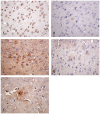The Role and Mechanism of Borneol to Open the Blood-Brain Barrier
- PMID: 29652199
- PMCID: PMC6142104
- DOI: 10.1177/1534735418767553
The Role and Mechanism of Borneol to Open the Blood-Brain Barrier
Abstract
Background: The blood-brain barrier (BBB) is the greatest challenge in the treatment of intracranial malignant tumors.
Objective: The aim of this study is to determine the role of borneol in opening the BBB and elucidate the underlying mechanisms.
Materials and methods: Twenty Sprague-Dawley (SD) rats were randomized into borneol group intragastrically administered with 10% borneol corn oil (2 mL/kg) and control group. After 30 minutes, 2% Evans blue (4 mL/kg) was injected. Thirty minutes later, brain tissue was analyzed using the Evans blue standard curve. Another 40 SD rats were randomized into high-, medium-, and low-dose borneol groups and a control group. Each rat in the experimental groups was intragastrically administered with 10% borneol corn oil (2 mL/kg, 1.25 mL/kg, and 0.5 mL/kg, respectively). The control group was injected with corn oil of 1.25 mL/kg. After 30 minutes, the rats were killed, and the brain tissues were collected. The expression of occludin, occludens-1, nitric oxide synthase, P-glycoprotein, and intercellular cell adhesion molecule-1 (ICAM-1) was detected by immunohistochemy.
Results: The concentration of Evans blue in the borneol group was higher than in the control group ( P < .05). The mean density of ICAM-1 expression was higher in the experimental group than in the control group ( P < .05). In contrast, significant differences of positive area and total density of ICAM-1 were shown only between the high-dose group and the control group ( P < .05).
Conclusion: Borneol can open the BBB, which might be related with the increased expression of ICAM-1.
Keywords: ICAM-1; SD rats; blood-brain barrier; borneol; traditional Chinese medicine.
Conflict of interest statement
Figures


Similar articles
-
Borneol Depresses P-Glycoprotein Function by a NF-κB Signaling Mediated Mechanism in a Blood Brain Barrier in Vitro Model.Int J Mol Sci. 2015 Nov 18;16(11):27576-88. doi: 10.3390/ijms161126051. Int J Mol Sci. 2015. PMID: 26593909 Free PMC article.
-
The mechanism of the opening of the blood-brain barrier by borneol: a pharmacodynamics and pharmacokinetics combination study.J Ethnopharmacol. 2013 Dec 12;150(3):1096-108. J Ethnopharmacol. 2013. PMID: 24432371
-
Borneol increases blood-tumour barrier permeability by regulating the expression levels of tight junction-associated proteins.Pharm Biol. 2016 Dec;54(12):3009-3018. doi: 10.1080/13880209.2016.1199044. Epub 2016 Jul 18. Pharm Biol. 2016. PMID: 27431008
-
[Effect factors and mechanisms of borneol's bidirectional regulation on blood-brain barrier permeability].Zhongguo Zhong Yao Za Zhi. 2017 Jun;42(11):2200-2207. doi: 10.19540/j.cnki.cjcmm.2017.0100. Zhongguo Zhong Yao Za Zhi. 2017. PMID: 28822169 Review. Chinese.
-
Borneol for Regulating the Permeability of the Blood-Brain Barrier in Experimental Ischemic Stroke: Preclinical Evidence and Possible Mechanism.Oxid Med Cell Longev. 2019 Feb 4;2019:2936737. doi: 10.1155/2019/2936737. eCollection 2019. Oxid Med Cell Longev. 2019. PMID: 30863478 Free PMC article. Review.
Cited by
-
Therapeutics for Chemotherapy-Induced Peripheral Neuropathy: Approaches with Natural Compounds from Traditional Eastern Medicine.Pharmaceutics. 2022 Jul 5;14(7):1407. doi: 10.3390/pharmaceutics14071407. Pharmaceutics. 2022. PMID: 35890302 Free PMC article. Review.
-
Trojan Horse Delivery Strategies of Natural Medicine Monomers: Challenges and Limitations in Improving Brain Targeting.Pharmaceutics. 2025 Feb 20;17(3):280. doi: 10.3390/pharmaceutics17030280. Pharmaceutics. 2025. PMID: 40142943 Free PMC article. Review.
-
Anticonvulsant Essential Oils and Their Relationship with Oxidative Stress in Epilepsy.Biomolecules. 2019 Dec 6;9(12):835. doi: 10.3390/biom9120835. Biomolecules. 2019. PMID: 31817682 Free PMC article. Review.
-
Gather wisdom to overcome barriers: Well-designed nano-drug delivery systems for treating gliomas.Acta Pharm Sin B. 2022 Mar;12(3):1100-1125. doi: 10.1016/j.apsb.2021.08.013. Epub 2021 Aug 14. Acta Pharm Sin B. 2022. PMID: 35530155 Free PMC article. Review.
-
Recent Progress on the Synergistic Antitumor Effect of a Borneol-Modified Nanocarrier Drug Delivery System.Front Med (Lausanne). 2021 Nov 25;8:750170. doi: 10.3389/fmed.2021.750170. eCollection 2021. Front Med (Lausanne). 2021. PMID: 34901063 Free PMC article. Review.
References
-
- Ferlay J, Shin HR, Bray F, Forman D, Mathers C, Parkin DM. Estimates of worldwide burden of cancer in 2008: GLOBOCAN 2008. Int J Cancer. 2010;127:2893-2917. - PubMed
-
- Alexandru D, Bota DA, Linskey ME. Epidemiology of central nervous system metastases. Prog Neurol Surg. 2012;25:13-29. - PubMed
-
- Bhatia SP, McGinty D, Letizia CS, Api AM. Fragrance material review on l-borneol. Food Chem Toxicol. 2008;46(suppl 11):S81-S84. - PubMed
-
- Zhang L, Han L, Qin J, Lu W, Wang J. The use of borneol as an enhancer for targeting aprotinin-conjugated PEG-PLGA nanoparticles to the brain. Pharm Res. 2013;30:2560-2572. - PubMed
-
- Xin HL, He XR, Li W, Zhou ZD, Zhang S, Wang GJ. The effect of borneol on the concentration of meropenem in rat brain and blood. J Asian Nat Prod Res. 2014;16:648-657. - PubMed
Publication types
MeSH terms
Substances
LinkOut - more resources
Full Text Sources
Other Literature Sources
Miscellaneous

